Rain or shine, it’s always a good time to check in with your people. A great way to do this is by taking a survey. A survey is a proven method for taking a pulse check of your people to see how they feel about different topics relating to the workplace and their jobs.
Giving your people a chance to speak their minds can provide companies with critical information on where they need to improve. To be the most effective, surveys should be conducted on a cadence, such as monthly or quarterly, with the results compared over time. While there’s no magic number when it comes to frequency, companies should have specific goals in mind when creating a survey and have the resources available to properly analyze the results. Most importantly, sharing the results and communicating how you plan to improve creates a culture of trust and transparency that your people will appreciate.
In times of uncertainty, when your people may feel insecure about their job security, it’s all the more important to understand how they feel so that you can address their fears and instill confidence in the company. And, if your people see that you are listening and acting on their feedback, this can do wonders for morale and wellbeing and positively impact retention.
Let’s take a closer look at different types of surveys you can use to gauge employee satisfaction and see how Bob’s surveys are easy for companies to set up and analyze, providing insights across teams, sites, or any other variable you choose.
Different surveys for different needs
There are several types of surveys companies can use to check in with their people.
- Employee lifecycle feedback surveys: These are non-anonymous surveys used to gather feedback from employees at different stages of their journey, such as after the first month, after the probation period, and at offboarding. Companies use this feedback to monitor and optimize their processes to improve the employee experience.
- Employee engagement surveys: These anonymous surveys gather feedback on employee sentiment and satisfaction and can include between 20 and 60 questions. Most effective when run at regular intervals, these surveys enable companies to see if their overall scores improve or worsen over time. Employee engagement surveys ask employees how they feel about different aspects of the organization and can include both scaled and open questions, inviting employees to write free text. They can also include the question, “How likely are you to recommend {company name} as a place to work?” which is the standard question for attaining an eNPS (Employee Net Promoter Score) for measuring employee satisfaction. Many companies run these surveys before and after a major change such as an acquisition or reorg to check employee sentiment. To ensure anonymity, these surveys should have a threshold of at least five people for best practice.
- Pulse surveys: These are similar to employee engagement surveys but usually include fewer questions. Pulse surveys enable companies to check in with their people frequently and gain a snapshot of how they are feeling with a survey that’s faster to run and analyze.
Bob’s surveys have a new, improved look and feel
Bob’s surveys are included in the Talent module and are a popular tool for checking in with your people and gaining insights into general sentiment. Having surveys as part of Bob enables you to keep all your employee data in one place and use your unique employee fields for consistency when setting up groups to analyze the data.
In response to customer requests and our constant efforts to improve and innovate, we’ve enhanced Company surveys, adding new capabilities and improving the overall design and user experience. We’ve made them easier to navigate—using just three easy steps—and added a new summary dashboard and other ways to analyze and compare results across the company, providing you with more insights to view and share. So, let’s take a look at what’s new.
Setting up surveys in Bob is as easy as one, two, three
Now, you can create a survey in Bob in just a few minutes using three easy steps.
1. Details:
Fill out all the details about the survey. Give it a name and an owner, and select the participants. You can also use your company’s customized fields for filtering results, enabling you to view the results the same way you view your organization. Then click “next”.
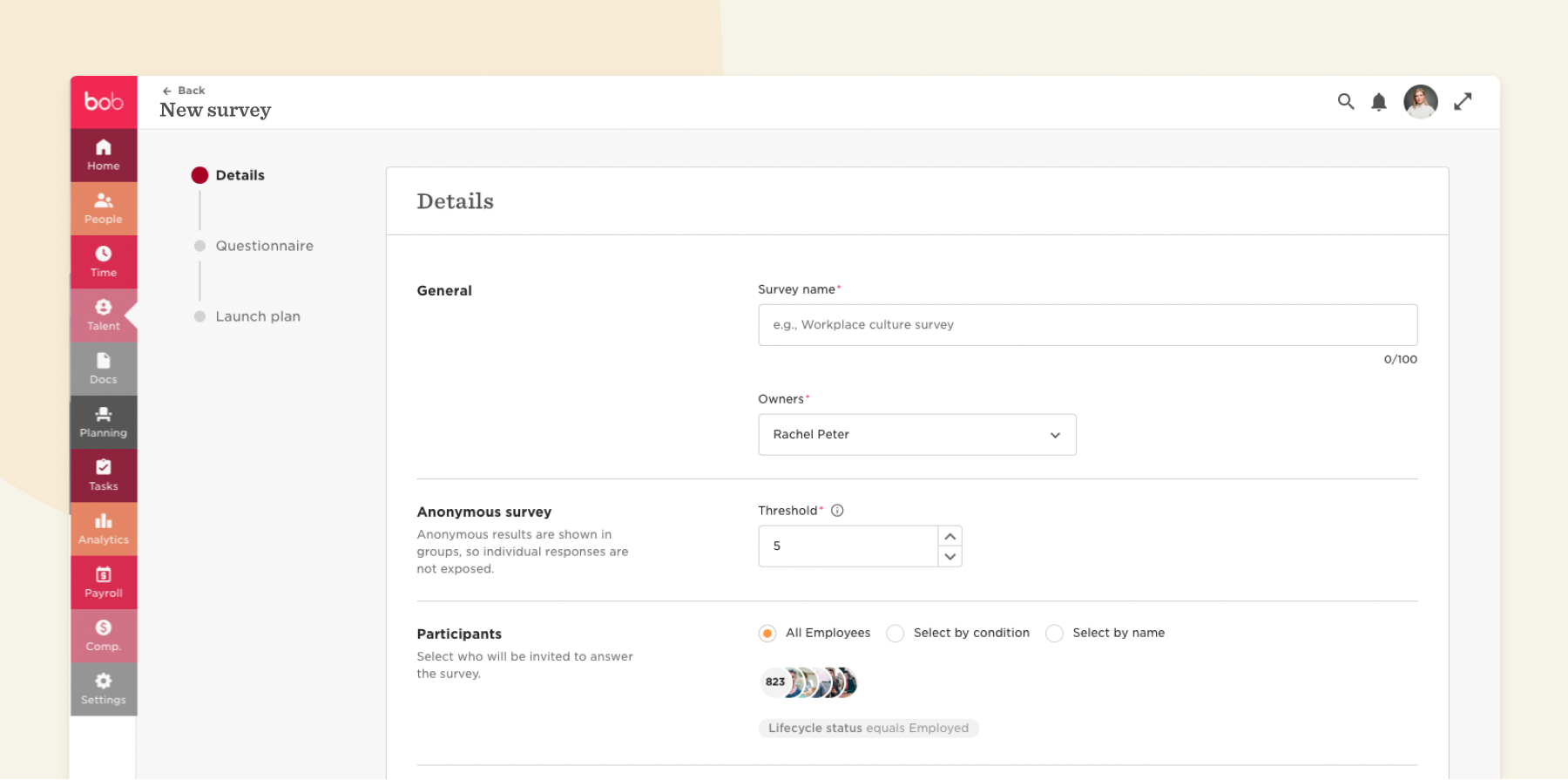
2. Questionnaire
Here, you can decide whether to use one of Bob’s pre-built templates or create your own from scratch. Bob’s templates can be used as is or as inspiration for your customized survey.
Bob includes templates on employee engagement, attitude and satisfaction, and quick surveys. Each category includes several templates for you to choose from. Once you have selected your template, it’s easy to edit or delete a question according to your specifications. By default, each question has a five-point scale, but you can change this to a four or seven-point scale or free text if this better suits your needs. You can also specify if a question is mandatory or add a title or a tip to help respondents when they are answering. When you’re finished, click “Save”.
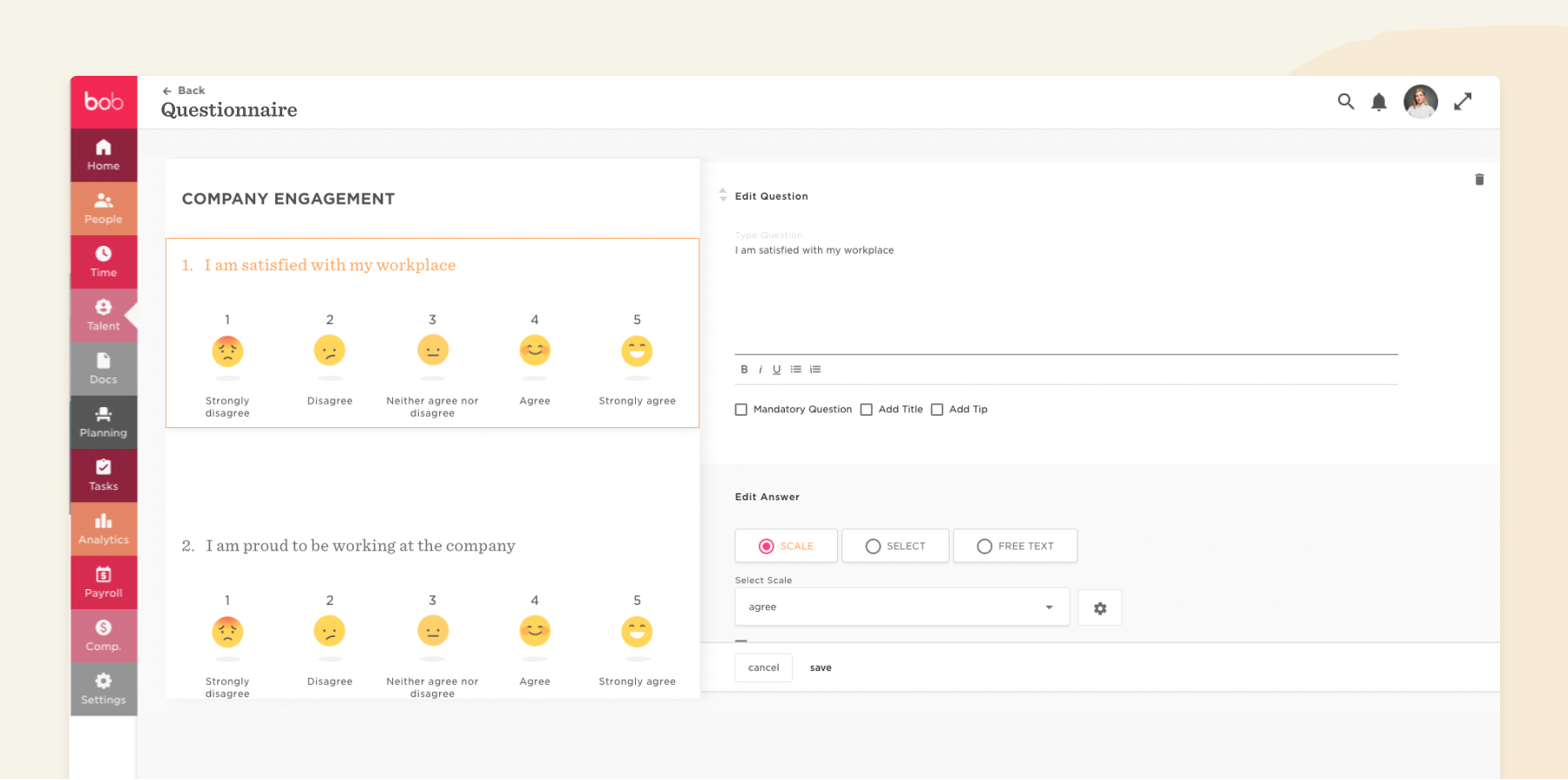
3. Launch plan
Here, you can simply set up the logistics of your survey, including the time frame that your people have to respond, who the survey will be sent by, and the text you want to include in the email when you send out the survey. When you’re done, press “Finish”. You will then enter a pre-launch screen that summarizes the survey. Click “Launch survey,” and your survey will be sent out to your chosen participants.
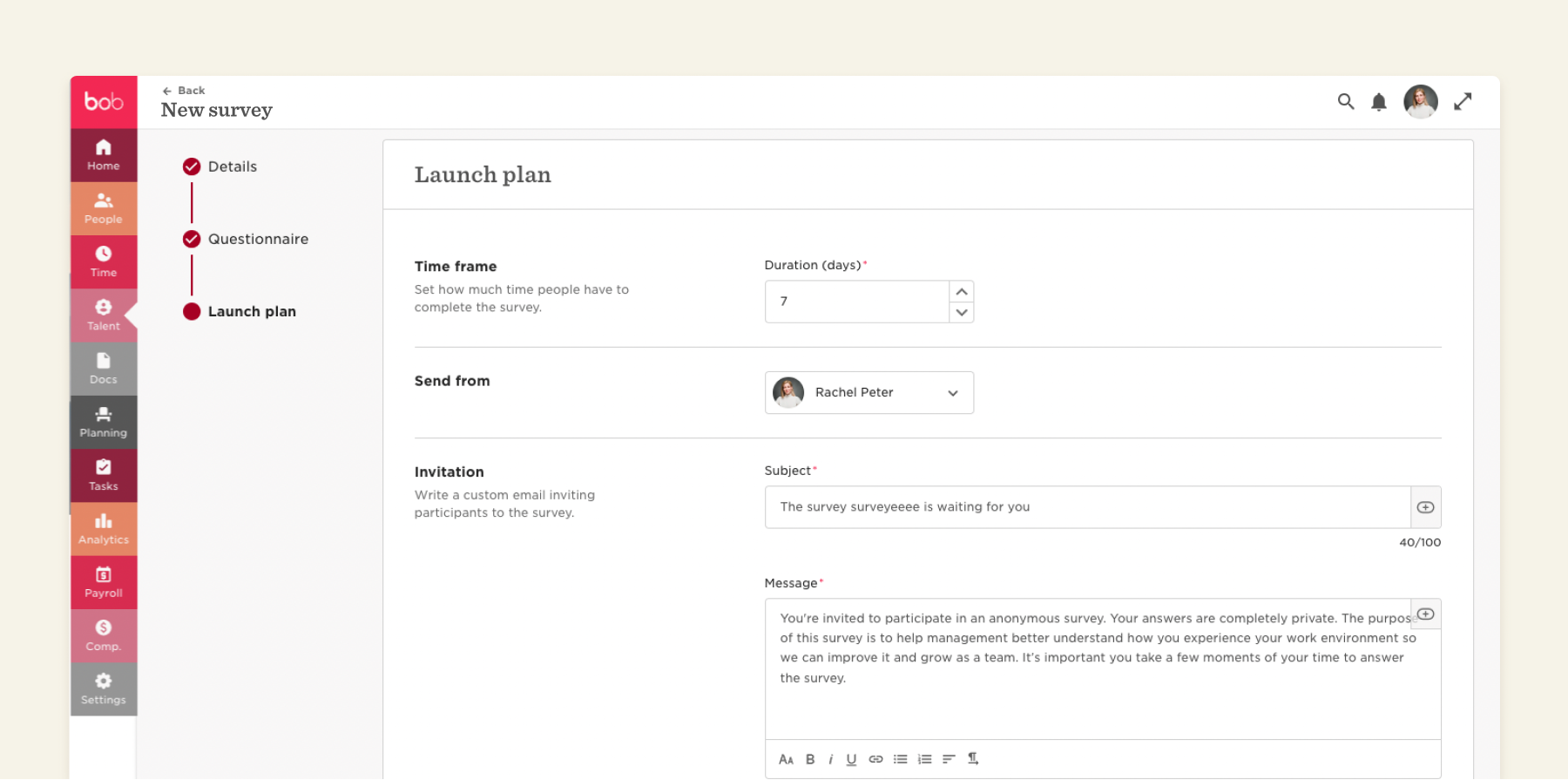
Recommended For Further Reading
Analyze your results with the new summary dashboard and heatmap
We’ve added a new summary dashboard that provides you with a high-level view of your survey results at a glance. You can see the survey’s overall score, participation rate, the highest and lowest scoring questions, including their scores, and opportunities for improvement. You can also view your company’s eNPS score if you have selected to include it in your survey. These results can also be viewed per site, department, or another group of your choice. You can also compare the survey’s overall score and participation with up to four previous surveys.
Click on any question to view the responses in more detail and compare them across different groups, such as departments or sites, to gain deeper insights about your organization. You can also view each question in more detail by clicking on the “Responses” tab. Here you will see the breakdown of each question, its score, and the percentages of positive, moderate, and negative responses. In the opportunities for improvement section, you can drill down to the questions that did not score well and see how much they impacted the survey’s overall score. For those that had a high impact, you can use this data to create a plan to try and improve the score for your next survey.
You can also view the responses to the open questions in your survey. For a quick review, filter comments by negative, moderate, or positive— a handy feature if your company has many employees or if you have a large number of comments to examine.
Note: To ensure your people’s anonymity, for all questions, you must have a minimum number of responses to view the results. The recommended number is at least five responses, but you can determine the anonymity threshold in settings.
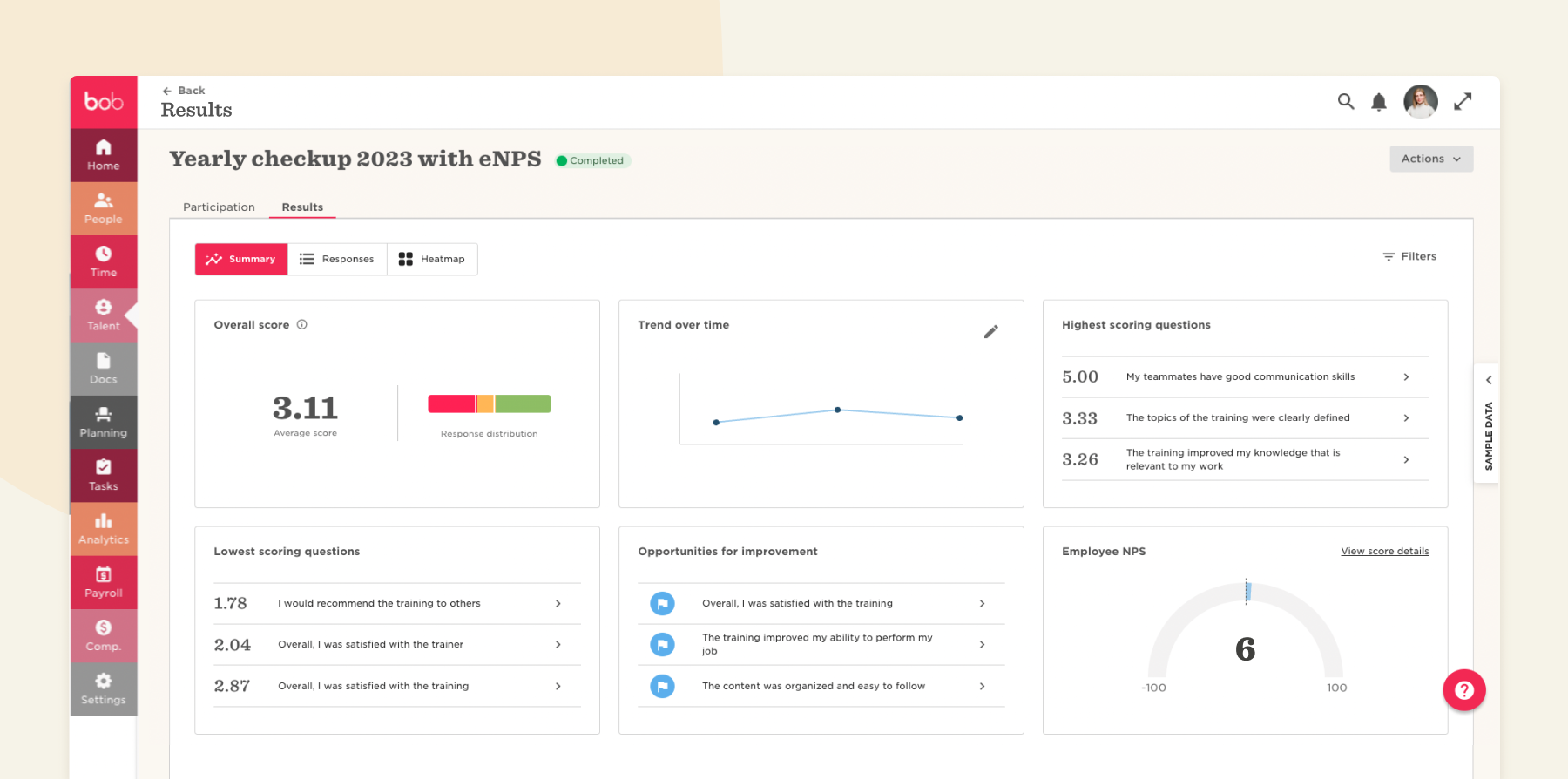
For another view of your results, click on “Heatmap”. Here you can see the questions broken down by theme and how the scores differ across departments, gender, age, or any other variable you choose, enabling you to quickly identify gaps across different groups within the company.
Use the results from your survey to discover how you can improve and take action. Share results with relevant stakeholders, such as C-level executives, management, or a specific team leader, by clicking on “Actions” and selecting “share results” from the dropdown menu.
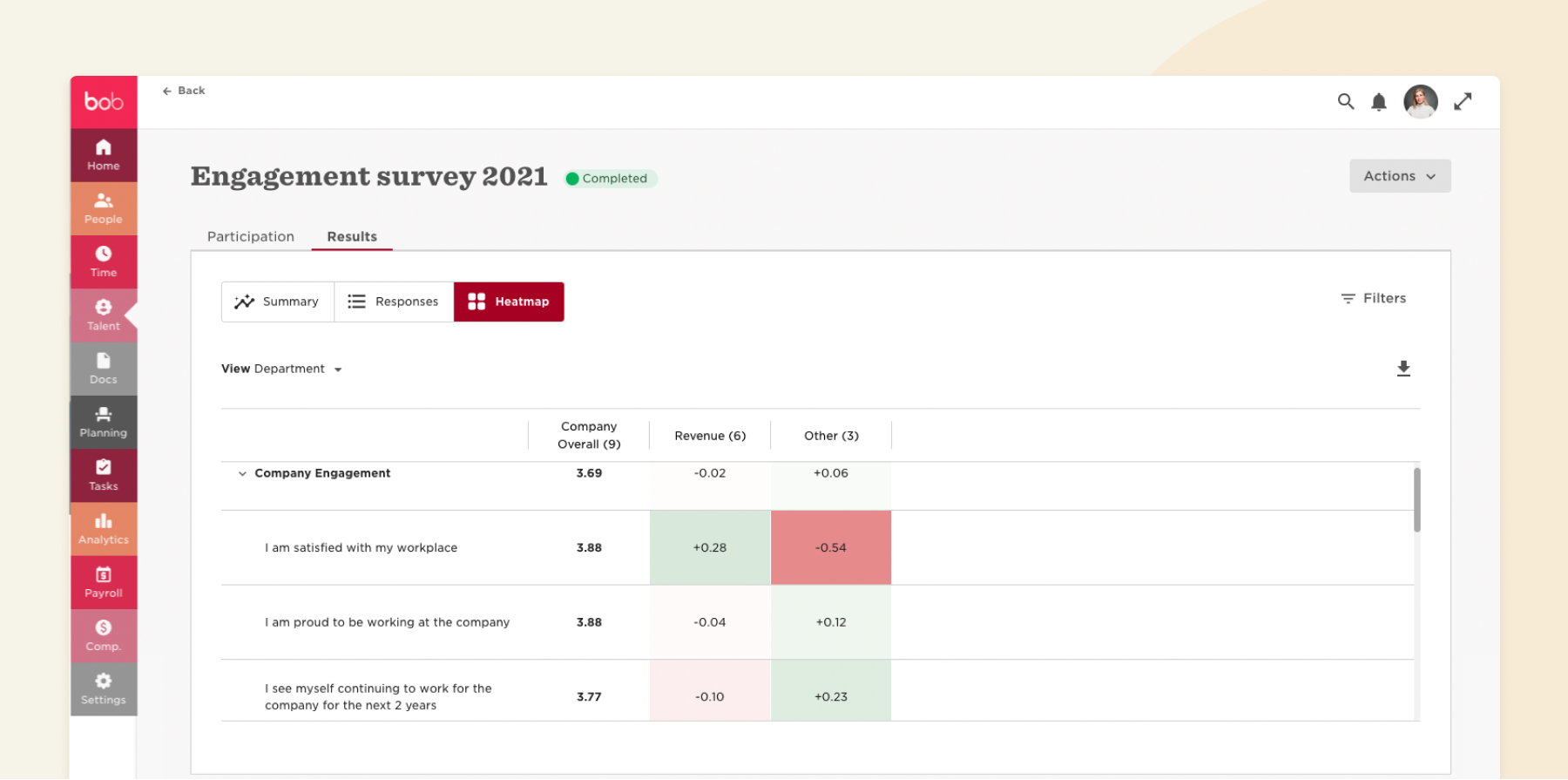
Create a better experience for your people
Surveys are a tried and tested method for collecting feedback from your people to inform change. Bob’s surveys can be set up in minutes and provide unparalleled insights that are easy to understand and can be used to compare sentiment from across your organization—by department, site, gender, or any other variable you choose. It’s always a worthwhile exercise to understand how your people feel about different aspects of the workplace. However, particularly in times of uncertainty, collecting that feedback—and showing your people that you are acting on it—can be instrumental for employee engagement, boosting morale, and ultimately increasing retention.


